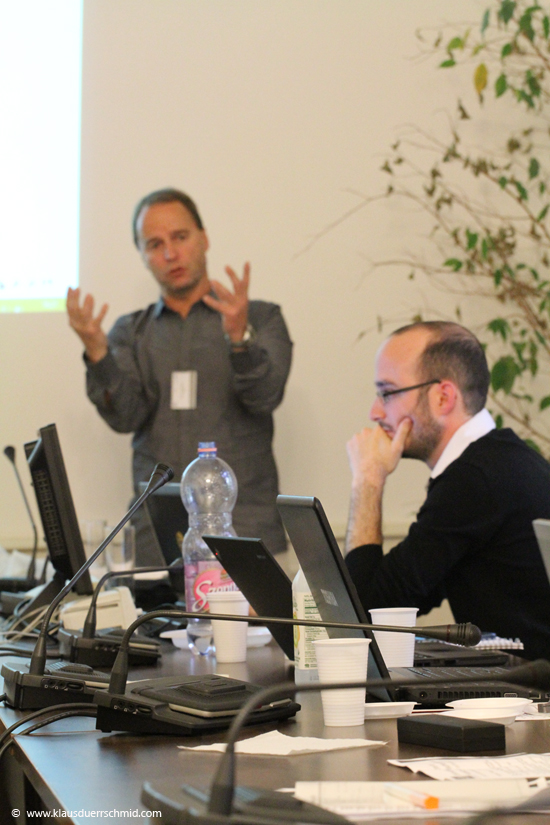New study: Capturing taste in time
30 May 2017 A study co-funded by the European Sensory Network (ESN) tested a new method to evaluate food. The conclusion: asking consumers to identify the dominating sensations during the eating process, while simultaneously asking them to indicate how much they like what they perceive, could help sensory analysts to better customize foods according to consumers' wishes. This new method, Temporal Drivers of Liking (TDL), is an extended version of the popular Temporal Dominance of Sensations (TDS), and could become part of the growing group of Rapid Sensory Profiling Methods. (Link to the publication)

Ready to be sampled. During an ESN meeting in Budapest in 2015, ESN members test the new method.
fleeting sensations
How does it taste? This sounds like a simple question, but the answer can be complex. First of all, the sensation we experience while eating or drinking usually changes every couple of seconds. For example, a cheese can taste mostly creamy in the first ten seconds, then cheesy, then bitter. To take this change of sensations into account, sensory scientists have developed a test that captures this dynamic. The test is called Temporary Dominance of Sensations (TDS). For example, the test person samples a piece of cheese and is asked to identify the sensation that is perceived as dominant while eating. “The study of temporal dominance is important in defining the specific flavor profile of many products and is therefore useful in defining the identity of a brand”, emphasizes Pascal Schlich from INRA, France.
four cheeses, six countries, nine partners
TDS became popular among sensory analysts in the last years. But some analysts realized that it had its limitations. For example, the test doesn´t provide information about whether or not the test person likes the dominant sensation. That´s why Pascal Schlich and Arnaud Thomas from ESN member INRA, France, designed an advanced version of the TDS. In this new test, the test person is asked to identify the sensations while eating and at the same time indicate on a nine-point scale how much they like what they perceive. For example, they might name the sensation creamy while eating the cheese and then mark a five on the liking scale, 10 seconds later they rate an eight on the liking scale, and so on. The test person can click at any time on the liking scale. This new version of the TDS is called Temporal Drivers of Liking (TDL). To determine whether TDL could help design and adjust products to the needs of the consumers, Pascal Schlich and Arnaud Thomas initiated a cross-cultural study that involved 667 consumers from six different countries.
tdl - a new tool in the box
The research involved nine ESN members*. The researchers asked the consumers to sample four different Gouda cheeses with different ages and fat contents (provided by ESN partner FrieslandCampina) during one session at the laboratory. On average, the consumers reported sensations for around half a minute and identified four attributes. “This is not an easy task for a naïve consumer”, explains Arnaud Thomas. “But our results show that it is doable.”

Arnaud Thomas (in the front) and Pascal Schlich, both from ESN member INRA, discuss the results with ESN members.
The data analysis identified three distinct consumer clusters. The first group liked the standard fat cheese the most and disliked the mature cheese (“standard group”). The second group liked the mature cheese and disliked the young low fat cheese (“mature group”). The third group liked the low-fat cheese and disliked the standard fat cheese (“lean group”). Only the members of the mature group liked their favorite cheese better when the sensation “sharp” was dominant. Only the members of the standard group liked the cheese better if they perceived the sensation “tender”.
getting more out of each bite
Thus, the liking scores increase or decrease when a certain attribute is dominant, but the change depends on the segment that the consumer belongs to. “Therefore, it is useful to find out about the liking segmentation before a TDL analysis determines which attribute should dominate during tasting for specific consumer targets”, explains Arnaud Thomas. TDL could be a new and useful approach for product developers in the food industry who want to design products with particular temporal sensory profiles for specific consumer groups. For instance, a mature cheese could be made sharper to please the mature group, and then advertised to this group in a special way. Accordingly, the lovers of standard cheese could be made happier by a more tender version of their cheese. When it comes to taste, we are all special.

* list of ESN members who participated
- Centre des Sciences du Goût et de l'Alimentation, CNRS, INRA, Univ. Bourgogne Franche-Comté, France (Arnaud Thomas, Pascal Schlich; project leaders)
- Biofortis Sensory & Consumer, France (Lise Dreyfuss)
- Campden BRI, UK (Marleen Chambault)
- Campden BRI, Hungary (Adrienn Hegyi)
- Escola Superior de Biotechnologia Universidade Catolica, Portugal (Ana Patricia Silva)
- isi, Germany (Sven Henneberg)
- Warsaw University of Life Sciences WULS-SGGW, Faculty of Human Nutrition and Consumer Sciences, Department of Functional Food, Ecological Food and Commodities, Poland (Elisa Kostyra)
- Wageningen Food & Biobased Research, Consumer Science & Health, The Netherlands (Stefanie Kremer, advisor)
- ACCE international, Canada (Chantal Gilbert, advisor)